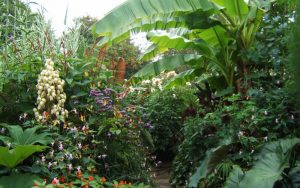
Tropic Life
True tropicals and tropical appearing plants have many uses in the north Florida garden. With their lushness, large leaves, colorful flowers, variegated foliage, and exotic and unusual features, they create a sense of place that feels right for this area. Even just a familiarity with a certain plant seen repeatedly in warm climates can make us think of the tropics. These plants are also compatible with pools and water features, and can provide a bridge between the spring annuals and perennials that slow or stop flowering in the heat, and the plants that won’t flower until it cools in Fall. True tropicals are best in the summer when hardy plants start to decline. They take the heat and humidity, producing flowers and fresh foliage until frost.
When you design your landscape, think of many layers of dense plantings. Tropical rainforests have certain specific features. You see plants growing on top of other plants, large and long leaves often with drip tips and sometimes with variegation, smooth trunks and hot, bright colors. Tropicals can be mixed in with hardy tropical-appearing plants to echo them or provide contrast. They can also be powerful focal points. Even the smaller tropicals can be bold focal points in containers. Low growing tender plants can be mixed in borders to step in when the annuals slow down and where they won’t compete with taller fall blooming perennials. Another great way to design with tropicals is to create beds in parts of your gar-den just for them. Instead of trying to overwinter some of your tropicals you can treat them as annuals, and change and redesign the bed each year. This method allows you to manage your plants much more efficiently since you won’t have to carefully plan and garden around your perennials in those areas. The beds can support cool season annuals like pansies and spring bulbs early in the season before the tropicals are ready to be planted, and many will share the space as the bulbs and less heat resistant plants go dormant.
Tropicals aren’t difficult to grow. Wait until the night temperatures stay above 50° to plant. Most prefer well-draining soil with average fertility but mulched. Some of the more hardy tropical-looking plants like cannas, gingers, bananas and elephant ears, do better in richer and moister soil. If you dispose of your tropicals at the end of the season, then you can fertilize even in late summer for a better end of sea-son display. If kept, smaller potted plants can be brought indoors or in garages/greenhouses for overwintering or covered with freeze cloth when necessary. See the following table for growth requirements and attributes for specific plants. In the table, the minimum temperature column reveals which of these useful plants are the hardy, tropical looking ones and which will need to be protected in winter or replaced in the spring. We are part of USDA hardiness zone 9a, with an average minimum winter low of 20°, so any-thing with a higher minimum isn’t hardy here.
To view or download this care guide as a PDF, click here.

